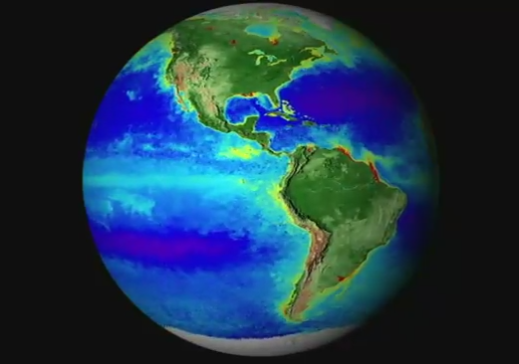NASA captured 20 years of changing seasons in a striking new global map of the home planet.
美国国家航空航天局(NASA)在一幅新的全球地图上捕捉到了20年来的季节变化。
The data visualization shows Earth's fluctuations as seen from space.
这一可视化数据展示了在太空中看到的地球的波动变化。
The polar ice caps and snow cover are shown ebbing and flowing with the seasons. The varying ocean shades of blue, green, red and purple depict the abundance - or lack - of undersea life.
显而易见,极地冰盖和积雪都随季节的变化而变化。蓝色、绿色、红色和紫色的不同海洋阴影,描绘了海底世界的丰富或缺乏。
"It's like watching the Earth breathe. It's really remarkable," said NASA oceanographer Jeremy Werdell, who took part in the project.
参与了这一项目的NASA海洋学者杰里米·维尔德尔表示:“这就像是在看地球呼吸,这真的很了不起。”
Two decades- from September 1997 to this past September - are crunched into 2.5 minutes of viewing.
从1997年9月到今年9月的这二十年,被压缩为这两分半钟的影像。

Werdell finds the imagery mesmerizing. "It's like all of my senses are being transported into space, and then you can compress time and rewind it, and just continually watch this kind of visualization," he said.
维尔德尔称,这段影像太令人着迷了。他说:“就像把我所有感受传输至宇宙中,然后你可以随意快进、倒带,并反复地观看这种可视化的过程。”
Werdell said the visualization shows spring coming earlier and autumn lasting longer in the Northern Hemisphere. Also noticeable to him is the receding of the Arctic ice caps over time - and, though less obvious, the Antarctic, too.
维尔德尔表示,图像显示北半球的春天来得越来越早,秋天变得更长。同样值得注意的是,北极的冰盖正在慢慢消融,南极也是这个情况,虽然不太明显。
On the sea side, Werdell was struck by "this hugely productive bloom of biology" that exploded in the Pacific along the equator from 1997 to 1998 -- when a water-warming El Nino merged into cooling La Nina. This algae bloom is evident by a line of bright green.
在海洋方面,“这一巨大的生物繁荣”让维尔德尔大为震惊--从1997年到1998年,在赤道附近的太平洋突然爆发--当时的厄尔尼诺暖流与拉尼娜寒流相融合。通过那一条显眼的绿带很明显的看出海藻的猛增。
In considerably smaller Lake Erie, more and more contaminating algae blooms are apparent - appearing red and yellow.
相对规模较小的伊利湖,其越来越多的污染藻类的大量繁殖显而易见,呈现出红色和黄色。
All this data can provide resources for policymakers as well as commercial fishermen and many others, according to Werdell.
维尔德尔认为,这些数据可以给政策制定者、商业捕鱼者以及其他人提供一些信息。












